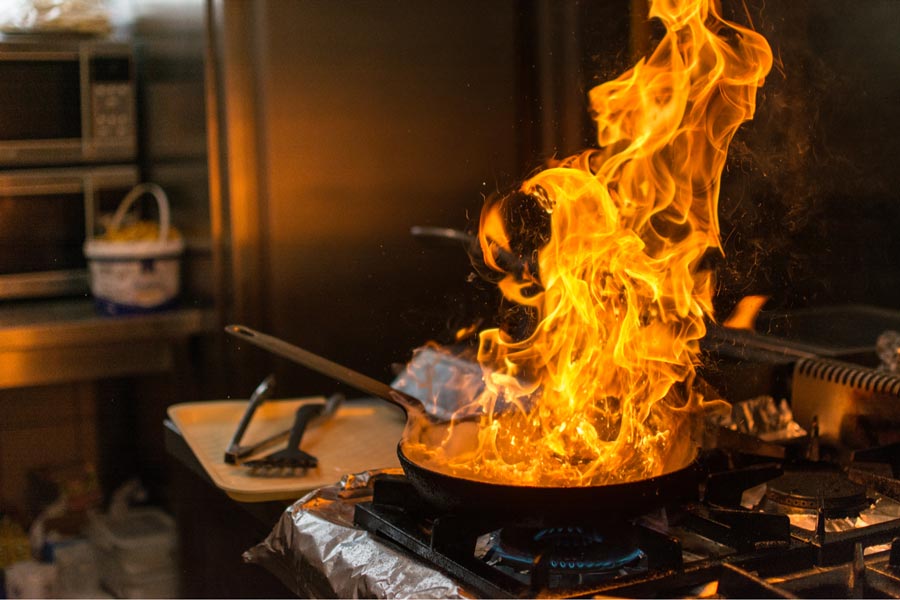Salt can be used to extinguish small grease fires, but it’s not as effective as other methods like using a fire extinguisher or smothering the fire with a lid or a fire blanket.
Moreover, salt can create a barrier between the flames and the oxygen, which can help smother the fire. However, for larger fires or fires involving materials other than grease, it’s safer and more effective to use a proper fire extinguishing method.
In addition, if you encounter a fire that is beyond your ability to control, it’s best to evacuate the area and call emergency services immediately.
How can salt be effectively utilized for addressing grease fires?
Amidst the sizzle of a kitchen mishap, salt takes center stage as a potent tool for tackling grease fires.
Explanation of Grease Fires and Their Characteristics
Grease fires occur when cooking oils or fats become overheated and ignite. Moreover, these fires are particularly dangerous due to the high temperatures involved and the potential for rapid spread. Additionally, grease fires can escalate quickly, leading to significant damage and even injury if not handled correctly.
Step-by-Step Process of Using Salt to Extinguish a Grease Fire
Assess the Situation: At first, if a small grease fire starts in a pan, immediately turn off the heat source if safe to do so. Do not attempt to move the pan, as this could spread the fire.
Apply Salt: Hence, carefully grab a handful of salt and sprinkle it directly onto the flames. Stand back to avoid the flames and heat.
Cover the Pan: However, if the fire does not immediately go out, cover the pan with a metal lid or a larger baking sheet to cut off the oxygen supply. Leave the lid on until the pan cools down.
Wait and Monitor: Finally, keep an eye on the covered pan and wait for it to cool completely. Do not remove the lid too soon, as there might still be residual heat that could reignite the fire.
Safety Precautions and Alternatives
Safety First: Firstly, always prioritize your safety. If the fire is too large or spreading rapidly, do not attempt to fight it yourself. Evacuate the area and call emergency services.
Alternatives: Hence, while salt can be effective for small grease fires, it’s essential to have a fire extinguisher in the kitchen that is rated for grease fires.
Moreover, a Class K fire extinguisher is designed specifically for kitchen fires involving oils and fats. Additionally, having a fire blanket on hand can also help smother small fires safely.
How Fire Extinguishing Works?

Fire extinguishing is a delicate interplay of elements, where the dance between fuel, heat, and oxygen determines the fate of the flames.
Explanation of the Fire Triangle: Fuel, Heat, Oxygen
Fire requires three elements to burn: fuel, heat, and oxygen. This trio is commonly referred to as the fire triangle. Moreover fuel is the material that burns, heat is required to reach the ignition temperature of the fuel, and oxygen supports the combustion process.
Additionally, removing any one of these elements can extinguish a fire. For example, fire extinguishers often work by removing oxygen or cooling the fire below its ignition temperature.
Methods of Fire Suppression: Smothering, Cooling, Removing Oxygen
Smothering: Basically, this method involves covering the fire with a non-flammable material to cut off its access to oxygen. Without oxygen, the fire can’t sustain itself.
Examples of smothering materials include sand, foam, and chemical agents that create a barrier between the fire and the air.
Cooling: Fires generate heat, and reducing the temperature below the ignition point of the fuel can extinguish the fire. Moreover, water is commonly used for cooling, as it absorbs heat from the fire, lowering the temperature and preventing re-ignition.
Removing Oxygen: Some fire extinguishing methods displace or remove the oxygen from the area around the fire.
In addition, carbon dioxide (CO2) fire extinguishers work this way; the CO2 displaces oxygen, suffocating the fire.
What is the significance of salt in the context of fire suppression?
In the realm of fire suppression, salt emerges as an unexpected yet intriguing ally, wielding its unique properties to quench flames and alter the course of combustion.
Mechanism of Salt’s Effect on Fire
Salt can be effective in fire suppression due to its ability to smother flames and displace oxygen. However, when salt is applied to a fire, it releases sodium ions that create a barrier between the fire and the oxygen in the air.
Additionally, this limits the oxygen available for combustion, causing the fire to weaken and eventually go out.
Types of Fires Where Salt Can Be Effective
Salt is particularly useful for small grease fires, such as those caused by cooking oils and fats. Additionally, grease fires can be challenging to extinguish because they involve high heat and can spread quickly. Salt helps cool the fire, form a barrier against oxygen, and prevent the fire from reigniting.
Limitations and Effectiveness Compared to Other Methods
Limitations: While salt can be effective for grease fires, it might not work as well for other types of fires. Moreover, it’s not recommended for electrical fires, chemical fires, or fires involving materials that won’t be affected by the smothering action of salt.
Effectiveness: Salt is a readily available and low-cost solution for small grease fires in a home kitchen. However, it’s important to note that dedicated fire extinguishers or other methods like covering the fire with a lid or using a fire blanket are more reliable and versatile options for various fire types.
What Are The Factors Influencing Salt’s Effectiveness?

Here the factors that influenced salt’s effectiveness:
Size and Intensity of the Fire
- Small fires are more likely to be successfully controlled with salt, as they have a limited oxygen supply to begin with.
- Moreover, larger and more intense fires might require a more robust extinguishing method, such as a fire extinguisher or professional intervention.
Type of Material Burning
Salt’s effectiveness can vary depending on the type of material that’s burning. It’s most effective for grease fires due to its smothering effect. Other materials might not be affected by salt in the same way.
Environment and Ventilation
Adequate ventilation can impact the effectiveness of using salt to extinguish a fire. Poor ventilation might hinder the oxygen displacement effect of the salt.
FAQs
Can salt really put out a fire?
Yes, salt can be effective in extinguishing small grease fires. It helps smother the flames and cut off the oxygen supply, which is essential for combustion.
Is it safe to use water on all types of fires?
No, water is not suitable for all types of fires. It can be effective for common combustibles like wood and paper, but it should not be used on grease fires or electrical fires due to the risk of spreading the fire or electrical shock.
What are the advantages of using foam fire extinguishers?
Foam fire extinguishers are effective for flammable liquid fires. They create a barrier on the fuel surface, preventing the release of flammable vapors and cooling the fire.
Can I use salt to extinguish an electrical fire?
No, using salt on an electrical fire is not recommended. Salt is not effective in removing the electrical source, and it could conduct electricity, making the situation worse. Use a Class C fire extinguisher designed for electrical fires.
Are there specific fire extinguishers for different types of fires?
Yes, there are fire extinguishers designed for specific fire classes. For example, Class A extinguishers are for ordinary combustibles, Class B for flammable liquids, and Class K for kitchen fires involving oils and fats.
Can I use a fire blanket to put out any type of fire?
Fire blankets are effective for smothering small fires involving people’s clothing or other personal items. However, they might not be suitable for larger fires or fires involving chemicals.
How does a CO2 fire extinguisher work?
CO2 fire extinguishers work by displacing oxygen, effectively smothering the fire. They are commonly used for electrical fires and flammable liquids.
Conclusion:
In conclusion, understanding the dynamics of fire suppression methods, including the role of salt, is crucial for effective and safe fire management.
Moreover, the fire triangle of fuel, heat, and oxygen provides the foundation for comprehending how fires ignite and sustain themselves. Additionally, different fire suppression methods, such as smothering, cooling, and removing oxygen, exploit these principles to extinguish fires.
While salt can be a useful tool in specific scenarios, particularly for small grease fires, its effectiveness is limited to situations where its smothering effect and oxygen displacement can be impactful.
In addition, it’s important to recognize that other dedicated fire extinguishing agents, like water, foam, and CO2, offer broader applicability for various fire types.
Understanding the characteristics of grease fires and the step-by-step process of using salt to extinguish them provides an additional layer of fire safety knowledge, especially in the context of home kitchens.
However, safety precautions must always be paramount, and alternatives such as proper fire extinguishers and fire blankets should be readily available.
Finally, factors influencing salt’s effectiveness, such as fire size, material type, and environmental conditions, underscore the importance of adapting fire suppression methods to the specific situation at hand. Careful consideration of these factors empowers individuals to make informed choices in their response to fires











